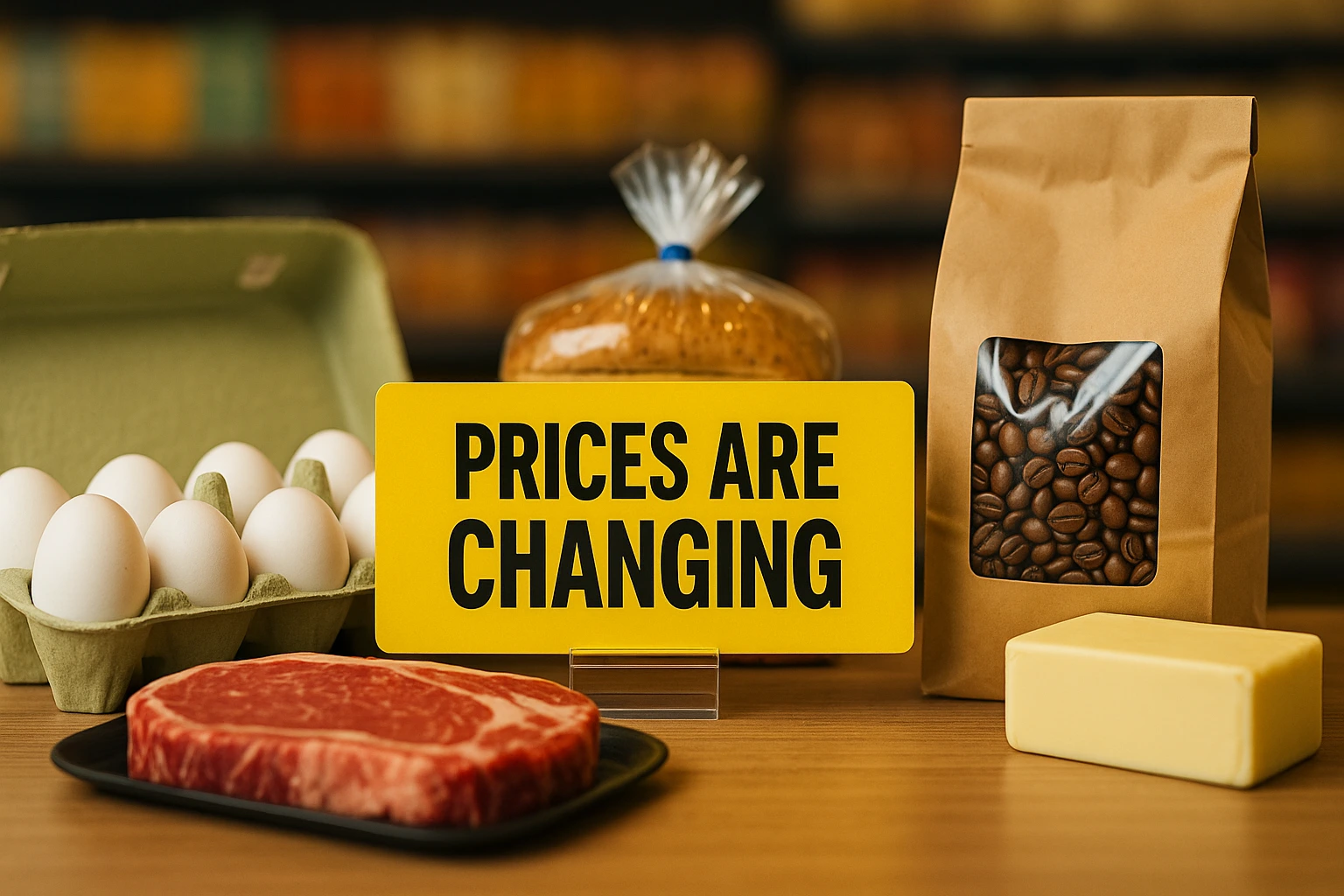Food prices in the U.S. have shifted again in 2025. From rising egg and coffee costs to steak price hikes, here’s how grocery inflation is impacting your wallet.
Table of Contents
🥩 Prices Are Changing: See How Much Basic Grocery Items Cost Now (2025 Update)
Grocery shopping in America isn’t what it used to be.
From the aftermath of the COVID-19 pandemic to weather-driven shortages and global economic shifts, your grocery bill has seen real changes—and some items might surprise you.
In 2025, although food inflation has eased overall, specific staples like eggs, coffee, and steak remain volatile due to supply chain pressures, disease outbreaks, and climate impacts.
Let’s dive into how much prices have changed—and what’s likely to come next.
📈 Food Inflation: From Pandemic Peaks to 2025 Stabilization
Food prices soared during the pandemic and in the inflationary period that followed. According to the Consumer Price Index (CPI) data, inflation for groceries—also known as “food at home”—has cooled from its peak but is still above pre-pandemic levels.
✅ Key CPI Trends:
- 2020–2022: Food at home inflation peaked at 13.5% YoY
- 2023–2024: Prices began stabilizing
- 2025: Inflation for groceries has slowed to around 2.6%, returning to historical averages
🥚 Eggs: Still Cracked by Avian Flu
Earlier this year, avian flu outbreaks disrupted poultry farms across the Midwest, reducing egg supply and causing prices to spike by nearly 30% YoY in Q1 2025.
“Prices have dropped slightly in June, but volatility may continue through fall,” say USDA analysts.
☕ Coffee: Climate Impacts Brew Higher Prices
Coffee prices have been rising for five consecutive months, driven by extreme droughts in Brazil and shipping delays across the Panama Canal.
- Average cost of ground coffee: $6.82/lb (↑ 8% YoY)
- Arabica futures hit highest levels since 2014
Analysts warn prices could rise another 10–15% by late 2025.
🥩 Steak: High Demand, Low Supply = Rising Prices
Steak prices are climbing again due to feed shortages, reduced cattle inventory, and supply chain costs.
- Ribeye prices now average $13.99/lb (↑ 7.4% YoY)
- Experts forecast steady increases through holiday season
🛒 Other Grocery Staples: Mixed Trends
| Product | July 2024 Avg Price | July 2025 Avg Price | Change |
|---|---|---|---|
| Milk (1 gallon) | $4.18 | $4.21 | +0.7% |
| Bread (loaf) | $2.71 | $2.75 | +1.5% |
| Chicken (whole) | $1.80/lb | $1.74/lb | -3.3% |
| Butter (1 lb) | $4.59 | $4.42 | -3.7% |
🌎 Global Politics & Tariffs Impacting U.S. Food Costs
President Trump’s renewed global tariff proposals, especially targeting imports from China and Latin America, are putting upward pressure on foods like:
- Canned vegetables
- Seafood (shrimp, tilapia)
- Packaged snacks
These trade tensions may drive future price hikes in late 2025 if enacted.
💡 What Can Shoppers Expect for the Rest of 2025?
While core food inflation has cooled, volatility remains due to:
- Climate-related crop disruptions
- Potential tariff implementation
- Ongoing logistics slowdowns
To manage costs, shoppers may benefit from:
- Buying in bulk
- Using loyalty programs
- Watching monthly CPI updates
📌Read More = Microsoft Cuts Off China-Based Engineers From Pentagon Cloud Support Amid Security Concerns
❓FAQs: Grocery Prices & Inflation in 2025
Q1: Are grocery prices still rising in 2025?
Yes, though overall inflation has stabilized, key items like eggs, coffee, and steak continue to rise in price due to external pressures like avian flu and climate events.
Q2: Why did egg prices go up in 2025?
Avian flu outbreaks have caused supply disruptions, leading to a sharp increase in egg prices during the first half of the year.
Q3: Is food inflation the same as general inflation?
No. Food inflation is a specific component of the Consumer Price Index (CPI) and focuses only on the cost of food at home and dining out.
Q4: What grocery items are cheaper in 2025?
Items like whole chicken and butter have seen slight price decreases as supply chains normalize and demand adjusts.
